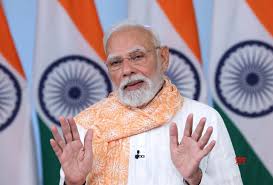
PM Begins Visit to Flood-Hit Himachal, Punjab; Assures Full Support to Affected People

 :
| Updated On: 09-Sep-2025 @ 1:10 pm
:
| Updated On: 09-Sep-2025 @ 1:10 pmSHARE
Ahead of his visit to flood-ravaged regions in Himachal Pradesh and Punjab, Prime Minister Narendra Modi on Tuesday assured the nation that the government “stands shoulder to shoulder with the affected people.” The PM’s visit is a response to the severe flooding caused by an unprecedented rise in river levels and incessant rainfall, which has disrupted lives, inundated farmland, and displaced thousands. Modi emphasized that in this hour of crisis, the government remains fully committed to providing support, relief, and assistance to the people affected by the calamity.
Modi’s visit is scheduled as a day-long tour, beginning with Himachal Pradesh. There, he is expected to take stock of the situation firsthand, assessing the impact of the floods and coordinating with state authorities on immediate relief measures. Following this, he will head to Punjab to conduct an aerial survey of the flood-affected areas. The Prime Minister’s plan includes visiting Gurdaspur, one of the worst-hit districts, which has seen 329 villages impacted, 1.45 lakh residents affected, and around 40,000 hectares of farmland submerged. Reports indicate that this district has suffered extensive damage due to both river flooding and landslides triggered by the heavy rains.
In Gurdaspur, PM Modi is scheduled to meet senior officials and hold review meetings to understand the ground situation better. He will also interact with local residents impacted by the floods and landslides, ensuring that their immediate concerns and needs are addressed. In addition, he will meet personnel from the National Disaster Response Force (NDRF), State Disaster Response Force (SDRF), and the Aapda Mitra team to review ongoing rescue and relief operations. The government has put in place tight security arrangements to facilitate the smooth and safe conduct of the PM’s visit.
The Punjab flood crisis has been particularly severe this season, peaking during the last week of August and the first week of September. The Aam Aadmi Party-led state government has declared all 23 districts as flood-hit, reflecting the widespread nature of the disaster. As per the latest data, the flood has claimed 51 lives and damaged crops on approximately 1.84 lakh hectares of agricultural land. The floods have severely affected rural communities, disrupting daily life and livelihoods, and necessitating urgent relief and rehabilitation measures.
The floods in Punjab are primarily attributed to swollen rivers, including the Sutlej, Beas, and Ravi, combined with seasonal rivulets fed by heavy rainfall in Himachal Pradesh and Jammu & Kashmir. Punjab’s Water Resources Minister Barinder Kumar Goyal noted that the water flow in the rivers this year has been unprecedented, emphasizing the severity of the natural disaster and the scale of the response required. The combination of high river levels, continuous rain, and resultant landslides has led to large-scale displacement and damage across multiple districts.
PM Modi’s visit demonstrates the central government’s commitment to supporting state administrations in disaster relief and rehabilitation efforts. By personally visiting the affected areas, coordinating with officials, and reviewing rescue operations, the Prime Minister aims to ensure a swift and efficient response to the floods. His engagement underscores the government’s priority of standing in solidarity with affected communities, providing immediate assistance, and working toward long-term recovery and restoration of normalcy in the flood-hit regions.
In summary, the Prime Minister’s visit to Himachal Pradesh and Punjab highlights the gravity of the ongoing flood crisis, the government’s proactive response, and the focus on both immediate relief and coordinated disaster management efforts. The floods, caused by extreme rainfall and swollen rivers, have affected tens of thousands of people, inundated farmland, and disrupted normal life. The PM’s engagements aim to provide direct relief, assess ground realities, and ensure that all necessary measures are taken for rescue, rehabilitation, and rebuilding efforts across the severely impacted districts.